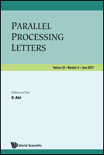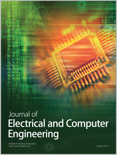
NEURAL PROCESSING LETTERS
Scope & Guideline
Advancing the Frontiers of AI and Neuroscience.
Introduction
Aims and Scopes
- Neural Network Architectures:
The journal covers advancements in various neural network architectures, including convolutional neural networks (CNNs), recurrent neural networks (RNNs), and hybrid models, focusing on their design, optimization, and application to complex problems. - Machine Learning Techniques:
It highlights innovative machine learning strategies, including supervised, unsupervised, and semi-supervised learning, as well as ensemble methods that enhance predictive performance and model robustness. - Applications in Medical Imaging and Healthcare:
A significant emphasis is placed on the application of neural networks in medical imaging, diagnostics, and healthcare analytics, showcasing how deep learning can improve patient outcomes and operational efficiency. - Theoretical Developments in Neural Processing:
The journal also emphasizes theoretical advancements, including stability analysis, convergence properties, and mathematical foundations of neural networks, ensuring a comprehensive understanding of neural processing. - Cross-Modal and Multi-Modal Learning:
Research on integrating various data modalities (e.g., visual, auditory, textual) to enhance learning outcomes and facilitate robust model performance across diverse applications.
Trending and Emerging
- Attention Mechanisms and Transformers:
There is a surge in research focused on attention mechanisms and transformer architectures, which are becoming increasingly popular for their effectiveness in various tasks, including natural language processing and image analysis. - Hybrid Deep Learning Models:
The integration of different deep learning models, such as CNNs with RNNs or transformers, to leverage the strengths of each architecture is gaining momentum, reflecting a trend towards more complex and capable models. - Explainable AI (XAI) and Interpretability:
Emerging interest in making neural networks more interpretable and explainable, with methodologies aimed at understanding the decision-making processes of deep learning models, is becoming a critical area of research. - Ethical AI and Bias Mitigation:
Research addressing ethical considerations in AI, including bias detection and mitigation in neural networks, is becoming increasingly relevant, reflecting societal concerns regarding fairness and accountability. - Real-Time and Edge Computing Applications:
There is a growing trend towards developing neural network solutions for real-time applications and edge computing, emphasizing the need for efficient algorithms that can operate on resource-constrained devices.
Declining or Waning
- Traditional Machine Learning Techniques:
There is a noticeable decrease in publications focusing on traditional machine learning algorithms in favor of deep learning approaches. This shift reflects the growing preference for neural networks and their capabilities over classical methods. - Basic Neural Network Models:
Research on fundamental neural network models without significant enhancements or novel applications has diminished, as the field increasingly values complex architectures and innovative adaptations. - Simple Feature Extraction Methods:
The trend shows a decline in interest toward basic feature extraction techniques, with a shift towards hybrid and advanced methods that combine multiple approaches for better performance.
Similar Journals

Foundations and Trends in Machine Learning
Decoding the Foundations of Tomorrow's AI TechnologiesFoundations and Trends in Machine Learning is a premier academic journal published by NOW PUBLISHERS INC, specializing in the cutting-edge fields of artificial intelligence, human-computer interaction, and software engineering. Since its inception in 2008, this journal has established a formidable reputation, attaining a Q1 ranking in 2023 across all three categories in the Scopus index, confirming its place among the elite publications in these disciplines. With an exceptional impact reflected in its standing as the top-ranked journal in Computer Science for both Software and Artificial Intelligence, researchers and practitioners alike turn to this resource for in-depth reviews and foundational insights that drive progress in the rapidly evolving landscape of machine learning. While currently operating under traditional access options, the journal invites a diverse audience, including students, researchers, and industry professionals, to deepen their understanding and contribute to knowledge in this dynamic area of study.

NEURAL COMPUTING & APPLICATIONS
Advancing the Frontiers of AI and Software EngineeringNEURAL COMPUTING & APPLICATIONS is a premier journal dedicated to the burgeoning fields of Artificial Intelligence and Software Engineering, published by Springer London Ltd. Established in 1993, the journal serves as a pivotal platform for disseminating cutting-edge research and innovative applications in neural computing, covering a broad range of topics from algorithm development to real-world applications. With its impressive categorization in the 2023 Journal Quartiles—ranging Q2 in Artificial Intelligence and Q1 in Software—it stands out in its discipline, ranking 42nd out of 407 in Computer Science Software and 50th out of 350 in Computer Science Artificial Intelligence, reflecting its significant impact in the academic community. Although not an open access journal, it provides vital access to significant findings and methodologies that drive advancements in technology. Researchers, professionals, and students looking to stay abreast of the most relevant and impactful developments in these fields will find NEURAL COMPUTING & APPLICATIONS an indispensable resource.

Frontiers in Computational Neuroscience
Innovating the Future of Neuroscience with Computational Precision.Frontiers in Computational Neuroscience, published by FRONTIERS MEDIA SA, is a leading journal within the fields of neuroscience and computational biology, dedicated to advancing the understanding of the brain's complex functions through innovative computational methodologies. Since its establishment in 2007, this Open Access journal has provided a platform for researchers around the globe to share their groundbreaking findings, as evidenced by its continual presence in the academic conversation and a strong ranking within Scopus metrics (Rank #12/49 in Neuroscience - Neuroscience (miscellaneous) and Rank #63/97 in Cellular and Molecular Neuroscience). With an esteemed impact factor reflective of its quality and influence, and a commitment to providing freely accessible research, this journal plays a crucial role in fostering collaboration and knowledge dissemination among professionals, researchers, and students alike. Located in the scientific hub of Switzerland, it invites submissions from diverse perspectives, aiming to bridge the gap between computational models and biological insights through rigorous peer-reviewed publications.

Machine Intelligence Research
Shaping Tomorrow's Technologies Through Rigorous ResearchMachine Intelligence Research is a premier academic journal published by SPRINGERNATURE, dedicated to advancing knowledge in the rapidly evolving fields of Artificial Intelligence, Applied Mathematics, and more. With its ISSN 2731-538X and E-ISSN 2731-5398, the journal is recognized for its impact, holding a distinguished position in various Q1 categories for 2023, including Computer Vision and Pattern Recognition and Control and Systems Engineering. Operating under an Open Access model, it ensures that groundbreaking research from China and around the world remains accessible to a global audience, promoting collaboration and innovation. As a beacon for researchers, professionals, and students, Machine Intelligence Research aims to disseminate high-quality research findings, innovative methodologies, and influential theories, thereby shaping the future landscapes of science and technology.

Parallel Processing Letters
Driving Excellence in Parallel Processing Research.Parallel Processing Letters is a notable academic journal published by World Scientific Publishing Co Pte Ltd, focusing on the dynamic fields of Computer Science, particularly in Hardware and Architecture, Software, and Theoretical Computer Science. Established in 1994, this journal provides a platform for the dissemination of cutting-edge research and developments in parallel processing and computational technologies. Despite its current Q4 ranking in multiple categories, Parallel Processing Letters plays an important role in fostering scholarly discussion and innovation within the computing community. With the ISSN 0129-6264 and E-ISSN 1793-642X, the journal is dedicated to maintaining rigorous academic standards while encouraging collaborative research conducive to the advancement of parallel processing systems. It serves as a valuable resource for researchers, professionals, and students seeking to deepen their understanding and gain insights into this rapidly evolving domain.

JOURNAL OF MATHEMATICAL IMAGING AND VISION
Elevating Research Standards in Mathematical ImagingJOURNAL OF MATHEMATICAL IMAGING AND VISION, published by Springer, stands as a significant platform for advancing the fields of applied mathematics, computer vision, and pattern recognition, among others. With an ISSN of 0924-9907 and an E-ISSN of 1573-7683, this esteemed journal is based in the Netherlands and has been contributing to the scholarly discourse since its inception in 1992, with a converged focus through 2024. It has achieved reputable standings within several quartiles, including Q2 rankings across applied mathematics, geometry and topology, and condensed matter physics, reflecting its impact and relevance. Notably, the journal ranks within the top 5% in Geometry and Topology and maintains robust standings in Statistics and Probability. The JOURNAL OF MATHEMATICAL IMAGING AND VISION is dedicated to publishing high-quality research that bridges theoretical perspectives with practical applications, making it an essential resource for researchers, professionals, and students who are exploring the cutting-edge of mathematical imaging and its interdisciplinary applications.

NETWORK-COMPUTATION IN NEURAL SYSTEMS
Illuminating the Complexities of Neural SystemsNETWORK-COMPUTATION IN NEURAL SYSTEMS is a distinguished journal published by Taylor & Francis Inc, focusing on the innovative intersection of network theory and neural computation. Since its inception in 1990, this journal has provided a vital platform for researchers and professionals in the field of neuroscience, exploring the dynamics of neural networks and computational models. With its current Q3 category ranking in Neuroscience (miscellaneous) and a robust position in Scopus, the journal plays a critical role in advancing knowledge and discussion within this interdisciplinary area. The journal addresses a wide range of topics related to the computational aspects of neural systems, fostering collaboration and providing valuable insights amongst scholars. Although it is not an open-access publication, its well-curated content remains accessible through institutional subscriptions, ensuring that significant research reaches the hands of those who need it. As it continues to evolve through 2024 and beyond, NETWORK-COMPUTATION IN NEURAL SYSTEMS stands as a key resource for anyone deeply engaged in understanding the complexities and intricacies of neural computations.

Cognitive Computation and Systems
Bridging Cognitive Science and Computational Excellence.Cognitive Computation and Systems is an innovative open-access journal published by Wiley, dedicated to advancing the fields of Artificial Intelligence, Cognitive Neuroscience, and Computer Science Applications. Based in the United Kingdom, this journal has established itself as a key resource for researchers, students, and professionals alike since its inception in 2019. With a focus on the convergence of cognitive theories and computational methodologies, Cognitive Computation and Systems aims to publish high-quality research that bridges holistic cognitive processing with algorithmic design. Although the journal is currently categorized in the lower quartiles of its fields, it provides a unique platform for disseminating pioneering ideas that can drive the vital intersection of computer vision, pattern recognition, and psychology. Scholars can take advantage of its open-access model, ensuring that research findings are freely available, thus promoting wider knowledge sharing and collaboration within these rapidly evolving domains. With its ambitious scope and commitment to quality, this journal is poised to make a significant impact in its respective fields.

IMAGING SCIENCE JOURNAL
Fostering Scholarly Dialogue in Imaging ResearchImaging Science Journal, published by Taylor & Francis Ltd, serves as a vital resource for researchers and professionals in the fields of computer vision, pattern recognition, and media technology. With an ISSN of 1368-2199 and an E-ISSN of 1743-131X, this journal has been fostering scholarly dialogue since its inception in 1997, with a converged content offering extending through 2024. Its categorization in Quartile 4 in Computer Vision and Pattern Recognition and Quartile 3 in Media Technology highlights its relevance and contributions to emerging trends in these domains. Although it ranks 36th in the Engineering - Media Technology category and 96th in Computer Science - Computer Vision and Pattern Recognition, its innovative research and insights continue to attract the attention of scholars dedicated to advancing knowledge at the intersection of imaging technologies. Offering versatile access options, this journal is essential for students, researchers, and professionals aiming to stay informed and engaged in the rapidly evolving landscape of imaging science.

Journal of Electrical and Computer Engineering
Transforming Knowledge into Engineering ExcellenceJournal of Electrical and Computer Engineering is a premier open-access journal published by HINDAWI LTD, dedicated to advancing the fields of electrical and computer engineering. With an ISSN of 2090-0147 and an E-ISSN of 2090-0155, this journal has been providing a platform for cutting-edge research since its inception in 2007. Based in the United States, it operates from its address at ADAM HOUSE, 3RD FLR, 1 FITZROY SQ, LONDON W1T 5HF, ENGLAND. The journal has established itself with a healthy impact factor, classified in the 2023 Q2 quartile for both Computer Science (Miscellaneous) and Electrical and Electronic Engineering, demonstrating its growing influence in the academic community. Additionally, its ranking positions it within the 67th percentile in General Computer Science and the 61st percentile in Electrical and Electronic Engineering on Scopus, indicating its significant contribution to these fields. Covering an extensive scope from 2010 to 2024, the journal seeks to publish innovative research articles, reviews, and case studies that explore new techniques and applications in electrical and computer engineering, benefiting a wide audience of researchers, professionals, and students focused on these rapidly-evolving areas.